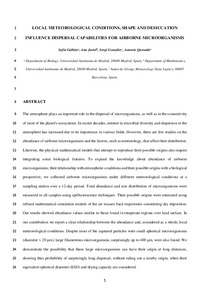Por favor, use este identificador para citar o enlazar este ítem:
http://hdl.handle.net/20.500.11765/12885
Local meteorological conditions, shape and desiccation influence dispersal capabilities for airborne microorganisms
| Título : | Local meteorological conditions, shape and desiccation influence dispersal capabilities for airborne microorganisms |
| Autor : | Galbán, Sofía; Justel, Ana; González Herrero, Sergi



|
| Palabras clave : | Long-range dispersion; Meteorology; Size distribution; Back-trajectories; Equivalent spherical diameter; Desiccation |
| Fecha de publicación : | 2021 |
| Editor: | Elsevier |
| Citación : | Science of the Total Environment. 2021, 780, 146653 |
| Versión del editor: | https://dx.doi.org/10.1016/j.scitotenv.2021.146653 |
| Resumen : | The atmosphere plays an important role in the dispersal of microorganisms, as well as in the connectivity of most of the planet's ecosystems. In recent decades, interest in microbial diversity and dispersion in the atmosphere has increased due to its importance in various fields. However, there are few studies on the abundance of airborne microorganisms and the factors, such as meteorology, that affect their distribution. Likewise, the physical-mathematical models attempting to reproduce their possible origins also require integrating some biological features. We collected airborne microorganisms under different meteorological conditions at a sampling station over a 12-day period to expand the knowledge about abundance of airborne microorganisms, their relationship with atmospheric conditions and their possible origins with a biological perspective. Total abundance and size distribution of microorganisms were measured in all samples using epifluorescence techniques. Their possible origins were estimated using refined mathematical simulation models of the air masses back-trajectories considering dry deposition. Our results showed microbial abundance values similar to those found in temperate regions over land surface. In our contribution we report a clear relationship between the abundance and, considered as a whole, local meteorological conditions. Despite most of the captured particles were small spherical microorganisms (diameter < 20 μm), large filamentous microorganisms, surprisingly up to 400 μm, were also found. We demonstrate the possibility that these large microorganisms can have their origin at long distances, showing thus probability of remarkable long dispersal, without ruling out a nearby origin, when their equivalent spherical diameter (ESD) and drying capacity are considered. |
| Patrocinador: | This work was supported by the Spanish Agencia Estatal de Investigación (AEI) and Fondo Europeo de Desarrollo Regional (FEDER), Grant CTM2016-79741-R. |
| URI : | http://hdl.handle.net/20.500.11765/12885 |
| ISSN : | 0048-9697 1879-1026 |
| Colecciones: | Artículos científicos 2019-2022 |
Ficheros en este ítem:
| Fichero | Descripción | Tamaño | Formato | ||
|---|---|---|---|---|---|
| METEOROLOGICAL_SHAPE_... | 307,79 kB | Adobe PDF |  Visualizar/Abrir |
Los ítems de Arcimis están protegidos por una Licencia Creative Commons, salvo que se indique lo contrario.





